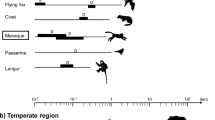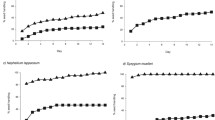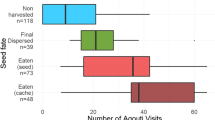Abstract
Despite the widespread use of seed/litter traps in seed dispersal ecology, several problems have arisen when using this method in forests inhabited by semi-terrestrial monkeys. The first issue is the height of the trap relative to the location where macaques spit seeds and/or defecate. For Japanese macaques in the lowland forests of Yakushima Island, southern Japan, 30–50 % of the seeds emitted from cheek pouches and faeces will not be caught by seed traps, leading to underestimation of seed fall. The second issue is the attractiveness of seed traps. Macaques sometimes play with the traps, potentially affecting the results of the seed-trap method in complex ways, including both negative and positive effects. To obtain reasonable estimates of total seed dispersal, we recommend that researchers conduct the seed-trap method concurrently with monkey observations, and that they should affix traps more securely to prevent macaques from destroying the traps.


Similar content being viewed by others
References
Au AYY, Corlett RT, Hau BCH (2006) Seed rain into upland plant communities in Hong Kong, China. Plant Ecol 186:13–22
Clark JS, Macklin E, Wood L (1998) Stages and spatial scales of recruitment limitation in southern Appalachian forests. Ecol Monogr 68:213–235
Hanya G (2005) Comparisons of dispersal success between the species fruiting prior to and those at the peak of migrant frugivore abundance. Plant Ecol 181:167–177
Harms KE, Wright SJ, Calderón O, Hernández Herre EA (2000) Pervasive density-dependent recruitment enhances seedling diversity in a tropical forest. Nature 404:493–495
Hoshizaki K, Suzuki W, Nakashizuka T (1999) Evaluation of secondary dispersal in a large-seeded tree Aesculus turbinate: a test of directed dispersal. Plant Ecol 144:167–176
Iida S (2006) Dispersal patterns of Quercus serrata acorns by wood mice in and around canopy gaps in a temperate forest. For Ecol Manage 277:71–78
Lee CS, Kim JH, You YH (2004) Seedling establishment and regeneration of Korean red pine (Pinus densiflora S. et Z.) forests in Korea in relation to soil moisture. For Ecol Manage 199:423–432
Lichstein JW, Grau HR, Aragón R (2004) Recruitment limitation in secondary forests dominated by an exotic tree. J Veg Sci 15:721–728
Masaki T, Kominami Y, Nakashizuka T (1994) Spatial and seasonal patterns of seed dissemination of Cornus controversa in a temperate forest. Ecology 75:1903–1910
Moles AT, Drake DR (1999) Potential contributions of the seed rain and seed bank to regeneration of native forest under plantation pine in New Zealand. NZ J Bot 37:83–93
Nathan R, Muller-Landau MC (2000) Spatial patterns of seed dispersal, their determinants and consequences for recruitment. Trends Ecol Evol 15:278–285
Otani T (2004) Effects of macaque ingestion on seed destruction and germination of a fleshy-fruited tree, Eurya emarginata. Ecol Res 19:495–501
Otani T, Shibata E (2000) Seed dispersal and predation by Yakushima macaques, Macaca fuscata yakui, in warm temperate forest of Yakushima Island, southern Japan. Ecol Res 15:133–144
Russo SE, Portnoy S, Augspurger SK (2006) Incorporating animal behaviour into seed dispersal models: implications for seed shadows. Ecology 87:3160–3174
Sato H (2013) Seasonal fruiting and seed dispersal by the brown lemur in a tropical dry forest, north-western Madagascar. J Trop Ecol 29:61–69
Stevenson PR, Ivonne NV (2008) Sample size and appropriate design of fruit and seed traps in tropical forests. J Trop Ecol 24:95–105
Tagawa H (1980) Vegetation on the western slope of Mt. Kuniwaridake, Yakushima Island. Science reports of Kagoshima University 29:121–137 (In Japanese)
Terakawa M, Matsui K, Hamada T, Noma N, Yumoto T (2008) Reduced seed dispersal effectiveness in the large-seeded tree Myrica rubra in the absence of the Japanese macaque on Tanegashima Island, Japan. Jpn J Conserv Ecol 13:161–167 (in Japanese with English summary)
Terborgh J (1986) Community aspects of fruigivory in tropical forests. In: Estrada A, Fleming TH (eds) Frugivores and seed dispersal. Springer, Netherlands, pp 371–384
Tsujino R, Yumoto T (2007) Spatial distribution patterns of trees at different life stages in a warm temperate forest. J Plant Res 120:687–695
Tsujino R, Yumoto T (2009) Topography-specific seed dispersal by Japanese macaques in a lowland forest on Yakushima Island, Japan. J Anim Ecol 78:119–125
Tsujino R, Takafumi H, Agetsuma N, Yumoto T (2006) Variation in tree growth, mortality and recruitment among topographic positions in a warm-temperate forest. J Veg Sci 17:281–290
Yumoto T, Noma N, Maruhashi T (1998) Cheek-pouch dispersal of seeds by Japanese monkeys (Macaca fuscata yakui) on Yakushima Island, Japan. Primates 39:325–338
Acknowledgments
We would like to thank our friends and colleagues in Yakushima for their hospitality and help during the fieldwork. We are also grateful to Yakushima Forest Environment Conservation Center for permission to undertake the research. The Sarugoya Committee and Field Research Center of the Primate Research Institute, Kyoto University offered us excellent facilities. This research was partly supported by grants for Biodiversity Research of the 21st Century COE (A14), Research Projects D-01 and D-02 of the Research Institute for Humanity and Nature, and by Research Fellowships of the Japan Society for the Promotion of Science for Young Scientists for R.T., as well as the Environmental Research and Technology Development Fund (S9) of the Ministry of the Environment, Japan.
Author information
Authors and Affiliations
Corresponding author
About this article
Cite this article
Tsujino, R., Yumoto, T. Problems associated with the seed-trap method when measuring seed dispersal in forests inhabited by Japanese macaques. Primates 55, 161–165 (2014). https://doi.org/10.1007/s10329-013-0403-1
Received:
Accepted:
Published:
Issue Date:
DOI: https://doi.org/10.1007/s10329-013-0403-1




